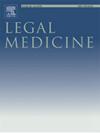Unusual pattern of firearm injury to trunk and limbs: Two case reports and review
IF 1.3
4区 医学
Q3 MEDICINE, LEGAL
引用次数: 0
Abstract
This article presents two cases of fatal injuries from rifled weapons with unconventional shapes of inlets and exits mismatched with the distance of firing. According to forensic literature, in long-distance ranges, we expected to see rounded entry wounds smaller than bullet size, circular in shape without associates with limited damage in the tissues. In the first case, there were large wounds which did not match a distance of more than 2 m, while in the second case, the distance was more than 30 m with large wounds 21 × 10 cm and massive damage to bones and lungs. In the first case, a 25-year-old male, he had multiple wounds in the front of the chest, the first one over the sternum end measuring 9 × 7 cm rounded in shape with fracture of the ribs, sternum and lung laceration. The second wound was 3 × 5 cm in the lateral aspect – mid axillary line and it was superficial due to tangential passage of the missile. In the left thigh, two inlets, each approximately 5 × 7 cm, were seen, the first one over the left iliac bone rounded and the second inlet was in the midshaft of the femur. The exit was below the left gluteus, rounded in shape 5 × 7 cm. The second case a 19-year-old male, he showed single oval wound in the middle third of the back, and it measured 21 × 10 cm. The missile passed tangentially and led to broken ribs and the vertebral column with a lung laceration.
躯干和四肢受枪伤的不寻常模式:两例报告和回顾
本文介绍了两例膛线武器造成的致命伤,这些武器的进弹口和出弹口形状非常规,与射击距离不匹配。根据法医文献,在远距离射击中,我们预计会看到小于子弹大小的圆形入口伤口,伤口呈圆形,不伴有组织的有限损伤。在第一起案件中,出现了与 2 米以上距离不符的大伤口,而在第二起案件中,距离超过 30 米,出现了 21 × 10 厘米的大伤口,骨骼和肺部严重受损。第一例是一名 25 岁的男性,他的前胸有多处伤口,第一处伤口位于胸骨末端,呈 9 × 7 厘米的圆形,肋骨、胸骨骨折,肺裂伤。第二处伤口位于外侧--腋中线,面积为 3 × 5 厘米,由于导弹切向穿过,伤口较浅。在左大腿上,可以看到两个入口,每个约 5 × 7 厘米,第一个在左髂骨圆形上方,第二个入口在股骨中轴。出口在左臀下方,呈 5 × 7 厘米的圆形。第二个病例是一名 19 岁的男性,背部中三分之一处有一个椭圆形伤口,大小为 21 × 10 厘米。导弹从切线方向穿过,导致肋骨和脊椎骨断裂,肺部撕裂。
本文章由计算机程序翻译,如有差异,请以英文原文为准。
求助全文
约1分钟内获得全文
求助全文
来源期刊

Legal Medicine
Nursing-Issues, Ethics and Legal Aspects
CiteScore
2.80
自引率
6.70%
发文量
119
审稿时长
7.9 weeks
期刊介绍:
Legal Medicine provides an international forum for the publication of original articles, reviews and correspondence on subjects that cover practical and theoretical areas of interest relating to the wide range of legal medicine.
Subjects covered include forensic pathology, toxicology, odontology, anthropology, criminalistics, immunochemistry, hemogenetics and forensic aspects of biological science with emphasis on DNA analysis and molecular biology. Submissions dealing with medicolegal problems such as malpractice, insurance, child abuse or ethics in medical practice are also acceptable.
 求助内容:
求助内容: 应助结果提醒方式:
应助结果提醒方式:


